A) E.
B) B + E.
C) D + E + F.
D) B + D + E + F.
F) A) and B)
Correct Answer

verified
Correct Answer
verified
True/False
Import quotas and tariffs both cause the quantity of imports to fall.
B) False
Correct Answer

verified
Correct Answer
verified
Multiple Choice
The before-trade price of fish in Greece is $3.00 per pound.The world price of fish is $5.00 per pound.Greece is a price-taker in the fish market.If Greece begins to allow trade in fish,its consumers of fish will become
A) better off, its producers of fish will become better off, and on balance the citizens of Greece will become better off.
B) worse off, its producers of fish will become better off, and on balance the citizens of Greece will become better off.
C) worse off, its producers of fish will become better off, and on balance the citizens of Greece will become worse off.
D) better off, its producers of fish will become worse off, and on balance the citizens of Greece will become worse off.
F) B) and C)
Correct Answer

verified
Correct Answer
verified
Multiple Choice
Which of the following is not a commonly-advanced argument for trade restrictions?
A) the jobs argument
B) the national-security argument
C) the infant-industry argument
D) the efficiency argument
F) A) and C)
Correct Answer

verified
Correct Answer
verified
Multiple Choice
Figure 9-9. The figure applies to the nation of Kenya and the good is air conditioners.
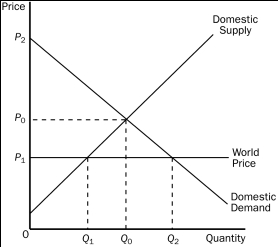 -Refer to Figure 9-9.Kenya's gains from trade are represented by the area that is bounded by the points
-Refer to Figure 9-9.Kenya's gains from trade are represented by the area that is bounded by the points
A) (0, P₀) , (Q₀, P₀) , (Q₂, P₁) , and (0, P₁) .
B) (0, P₁) , (0, P₂) , (Q₀, P₀) , and (Q₁, P₁) .
C) (Q₀, P₀) , (Q₂, P₁) , and (Q₁, P₁) .
D) (0, P₀) , (0, P₂) , and (Q₀, P₀) .
F) B) and C)
Correct Answer

verified
Correct Answer
verified
Multiple Choice
Figure 9-4
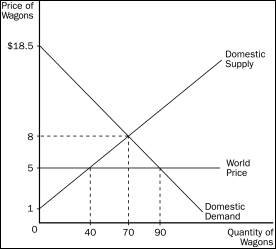 -Refer to Figure 9-4.Without trade,producer surplus amounts to
-Refer to Figure 9-4.Without trade,producer surplus amounts to
A) $210.
B) $245.
C) $450.
D) $455.
F) A) and B)
Correct Answer

verified
Correct Answer
verified
Multiple Choice
A tariff on a product
A) enhances the economic well-being of the domestic economy.
B) increases the domestic quantity supplied.
C) increases the domestic quantity demanded.
D) results in an increase in producer surplus that is greater than the resulting decrease in consumer surplus.
F) A) and C)
Correct Answer

verified
Correct Answer
verified
Multiple Choice
The world price of a pound of T-bone steak is $9.00.Before Guatemala allowed trade in beef,the price of a pound of T-bone steak there was $12.00.Once Guatemala began allowing trade in beef with other countries,Guatemala began
A) exporting T-bone steak and the price per pound in Guatemala remained at $12.00.
B) exporting T-bone steak and the price per pound in Guatemala decreased to $9.00.
C) importing T-bone steak and the price per pound in Guatemala remained at $12.00.
D) importing T-bone steak and the price per pound in Guatemala decreased to $9.00.
F) None of the above
Correct Answer

verified
Correct Answer
verified
Multiple Choice
Scenario 9-1 The before-trade domestic price of tomatoes in the United States is $500 per ton. The world price of tomatoes is $600 per ton. The U.S. is a price-taker in the tomatoes market. -Refer to Scenario 9-1.If trade in tomatoes is allowed,the price of tomatoes in the United States
A) will increase, and this will cause consumer surplus to decrease.
B) will decrease, and this will cause consumer surplus to increase.
C) will be unaffected, and consumer surplus will be unaffected as well.
D) could increase or decrease or be unaffected; this cannot be determined.
F) B) and D)
Correct Answer

verified
Correct Answer
verified
Multiple Choice
Figure 9-14
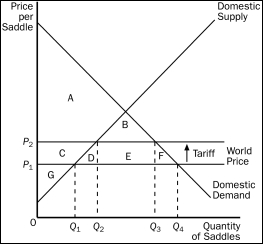 -Refer to Figure 9-14.With the tariff,the domestic price and domestic quantity demanded are
-Refer to Figure 9-14.With the tariff,the domestic price and domestic quantity demanded are
A) P₁ and Q₁.
B) P₁ and Q₄.
C) P₂ and Q₂.
D) P₂ and Q₃.
F) All of the above
Correct Answer

verified
Correct Answer
verified
Multiple Choice
Scenario 9-1 The before-trade domestic price of tomatoes in the United States is $500 per ton. The world price of tomatoes is $600 per ton. The U.S. is a price-taker in the tomatoes market. -Refer to Scenario 9-1.If trade in tomatoes is allowed,U.S.producers of tomatoes
A) will be better off.
B) will be worse off.
C) will be unaffected.
D) will experience a decrease in their collective producer surplus.
F) A) and C)
Correct Answer

verified
Correct Answer
verified
Multiple Choice
Figure 9-4
 -Refer to Figure 9-4.With trade,consumer surplus is
-Refer to Figure 9-4.With trade,consumer surplus is
A) $245.
B) $362.50.
C) $367.50.
D) $607.50.
F) C) and D)
Correct Answer

verified
Correct Answer
verified
Multiple Choice
Which of the following statements is true?
A) Free trade benefits a country when it exports but harms it when it imports.
B) "Voluntary" limits on Canadian exports of hogs are better for the United States than U.S.tariffs placed on Canadian hog exports.
C) Tariffs and quotas differ in that tariffs work like a tax and therefore impose deadweight losses, whereas quotas do not impose deadweight losses.
D) Free trade benefits a country both when it exports and when it imports.
F) None of the above
Correct Answer

verified
Correct Answer
verified
Multiple Choice
Figure 9-11
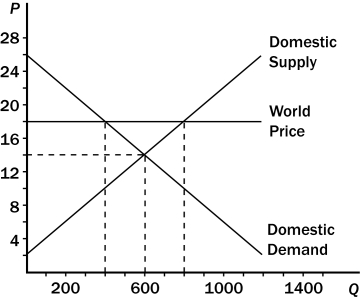 -Refer to Figure 9-11.With trade,the domestic price and domestic quantity demanded are
-Refer to Figure 9-11.With trade,the domestic price and domestic quantity demanded are
A) $18 and 400.
B) $18 and 800.
C) $14 and 400.
D) $14 and 600.
F) C) and D)
Correct Answer

verified
Correct Answer
verified
Multiple Choice
Import quotas and tariffs produce some common results.Which of the following is not one of those common results?
A) total surplus in the domestic country falls.
B) Producer surplus in the domestic country increases.
C) The domestic country experiences a deadweight loss.
D) Revenue is raised for the domestic government.
F) B) and C)
Correct Answer

verified
Correct Answer
verified
Multiple Choice
Figure 9-11
 -Refer to Figure 9-11.Consumer surplus before trade is
-Refer to Figure 9-11.Consumer surplus before trade is
A) $1,600.
B) $2,400.
C) $3,200.
D) $3,600.
F) A) and C)
Correct Answer

verified
Correct Answer
verified
Multiple Choice
Figure 9-12
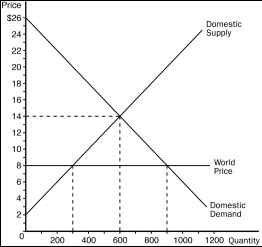 -Refer to Figure 9-12.With trade,the country
-Refer to Figure 9-12.With trade,the country
A) exports 200 units of the good.
B) exports 400 units of the good.
C) imports 400 units of the good.
D) imports 600 units of the good.
F) A) and D)
Correct Answer

verified
Correct Answer
verified
Multiple Choice
Figure 9-10
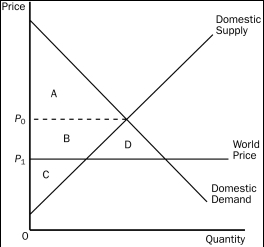 -Refer to Figure 9-10.Consumer surplus in this market after trade is
-Refer to Figure 9-10.Consumer surplus in this market after trade is
A) a.
B) C + B.
C) A + B + D.
D) B + C + D.
F) A) and B)
Correct Answer

verified
Correct Answer
verified
Multiple Choice
Which of the following assertions is not correct about the multilateral approach to free trade?
A) The multilateral approach has the potential to result in freer trade than does the unilateral approach.
B) The multilateral approach may have a political advantage over the unilateral approach.
C) The multilateral approach is simpler than the unilateral approach.
D) NAFTA and GATT are both multilateral approaches to free trade.
F) All of the above
Correct Answer

verified
Correct Answer
verified
Multiple Choice
Figure 9-7. On the diagram below, Q represents the quantity of cars and P represents the price of cars.
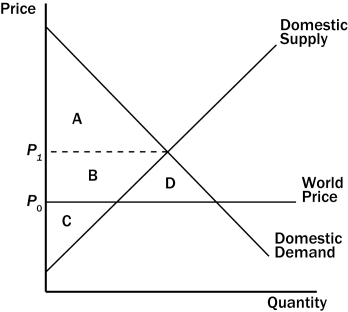 -Refer to Figure 9-7.The country for which the figure is drawn
-Refer to Figure 9-7.The country for which the figure is drawn
A) has a comparative advantage relative to other countries in the production of cars and it will export cars.
B) has a comparative advantage relative to other countries in the production of cars and it will import cars.
C) has a comparative disadvantage relative to other countries in the production of cars and it will export cars.
D) has a comparative disadvantage relative to other countries in the production of cars and it will import cars.
F) None of the above
Correct Answer

verified
Correct Answer
verified
Showing 161 - 180 of 245
Related Exams